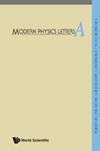库普曼-冯-诺伊曼力学中的l - leblond方程和Eisenhart-Duval升力
IF 1.6
4区 物理与天体物理
Q3 ASTRONOMY & ASTROPHYSICS
引用次数: 0
摘要
库普曼-冯·诺伊曼(KvN)力学是很久以前提出的一种方法,用来回答关于经典力学的希尔伯特空间表示是否存在的问题。KvN力学是一种非相对论性的理论,由于自旋被广泛认为是一种相对论性的性质,因此尚不清楚如何将自旋包含在其中。Cabrera等人,在欧洲。理论物理。[j] .力学与工程学报,2016(1):1 - 2。物理学,282,420(2000)]是与Dirac方程相对应的Koopman-von Neumann理论的正确经典框架。然而,在l本文章由计算机程序翻译,如有差异,请以英文原文为准。
Lévy-Leblond equation and Eisenhart–Duval lift in Koopman–von Neumann mechanics
The Koopman–von Neumann (KvN) mechanics is an approach that was formulated long ago to answer the question regarding the existence of a Hilbert space representation of classical mechanics. KvN mechanics is a non-relativistic theory, and it is not clear how spin can be included in it, since spin is widely regarded as a relativistic property. Cabrera et al., in Eur. Phys. J. Spec. Top. 227, 2195 (2019) argued that the Spohn equation [Spohn, Ann. Phys. 282, 420 (2000)] is the correct classical framework for the Koopman–von Neumann theory corresponding to the Dirac equation. However, after Lévy-Leblond’s seminal work on this topic, it became clear that spin naturally arises also from the Galilean invariant wave equations, without any need of relativistic considerations. Inspired by this, we propose another possibility of including spin in the KvN formalism: the Lévy-Leblond equation in the Koopman–von Neumann formalism can be obtained as a null reduction of the massless Dirac equation in the Eisenhart–Duval lift metric. To illustrate the idea, we implement it for a one-dimensional classical system without magnetic interactions.
求助全文
通过发布文献求助,成功后即可免费获取论文全文。
去求助
来源期刊

Modern Physics Letters A
物理-物理:核物理
CiteScore
3.10
自引率
7.10%
发文量
186
审稿时长
3 months
期刊介绍:
This letters journal, launched in 1986, consists of research papers covering current research developments in Gravitation, Cosmology, Astrophysics, Nuclear Physics, Particles and Fields, Accelerator physics, and Quantum Information. A Brief Review section has also been initiated with the purpose of publishing short reports on the latest experimental findings and urgent new theoretical developments.
 求助内容:
求助内容: 应助结果提醒方式:
应助结果提醒方式:


